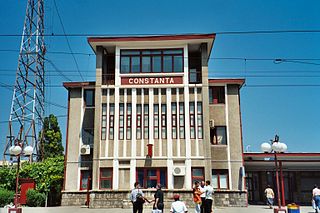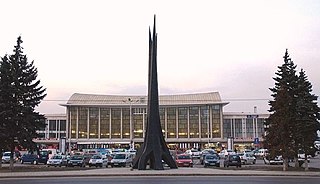Căile Ferate Române was the state railway carrier of Romania. The company was dissolved on 1 October 1998 by splitting into several successor companies. CFR as an entity existed from 1880, even though the first railway on current Romanian territory was opened in 1854. CFR was divided into four autonomous companies:
Christian Wilhelm Berger is a Romanian composer, organist, and a lecturer at the Bucharest Academy.

The Romanian Radio Broadcasting Company, informally referred to as Radio Romania, is the public radio broadcaster in Romania. It operates FM and AM, and internet national and local radio channels. The local stations are branded under the Radio România Regional umbrella.

The Romanian National Opera, Cluj-Napoca is one of the national opera and ballet companies of Romania. The Opera shares the same building with the National Theatre in Cluj-Napoca.

The Lucian Blaga National Theatre is in Cluj-Napoca, Romania, sharing its building with the Romanian Opera.

The regions represented the result of a Soviet-inspired experiment regarding the administrative and territorial organisation of the Romanian People's Republic between 1950 and 1968.

Constanţa railway station is the largest station in Constanţa and on the Romanian Black Sea coast.

The Brașov railway station is the main station in Brașov, Romania. The building on the current location was opened to traffic in 1962. The station's bell chimes preceding the announcements represent a few notes from Ciprian Porumbescu's operetta Crai Nou.

Iași railway station is the main railway station in Iași, and one of the oldest in Romania. It is part of the Pan-European Corridor IX.

Gábor Tompa is an internationally renowned Romanian theater and film director, poet, essayist and teacher. Between 2007 and 2016 he was the Head of Directing at the Theatre and Dance Department of the University of California, San Diego. He is the general and artistic director of the Hungarian Theatre of Cluj since 1990, the theatre is member of the Union of the Theatres of Europe (UTE) since 2008. Founder and artistic director of the Interferences International Theatre Festival in Cluj, Romania. President of the Union of the Theatres of Europe since 2018.
Sala Polivalentă may refer to:
Mircea Dumitrescu was a film critic, professor and essayist. He was known especially for his cinematography course accompanied by screenings in the main university cities in Romania.
The 2012–13 Liga Națională was the 55th season of Romanian Women's Handball League, the top-level women's professional handball league. The league comprises 11 teams. Z-Terom Iaşi did not register for the new season because it was dissolved. Oltchim Râmnicu Vâlcea were the defending champions, for the sixth season in a row.
Ștefan Pop is a Romanian operatic tenor. He is considered among today's leading lyric tenors and he is best known for bel canto repertoire. He has won several prizes including, in 2010, Plácido Domingo's Operalia competition and the Seoul International Music Competition.
The 1946–47 Divizia B was the eighth season of the second tier of the Romanian football league system.
Viorel Cosma was a Romanian musician and teacher who came to wider prominence as an exceptionally prolific musicologist and a pioneering lexicographer. Through his scholarship he also achieved distinction as a teacher, researcher and music critic. Between 1989 and 2012 he produced a ten volume lexicon, running to 2,800 pages, entitled "Muzicieni din România", providing extensive information on approximately 1,500 Romanian composers and musicians, musicologists, music critics, music teachers, folklorists and other contributors to Romanian music and musicianship.







